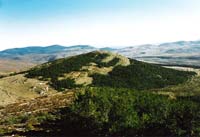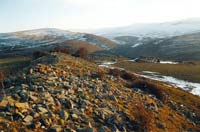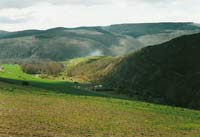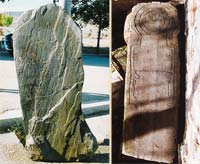
The archaeological heritage of the Highlands matches with the wild environment that surrounds it, as it is placed in the middle part of the Iberian Mountain Range bordering the Northwest of the Castilian Plateau. Apart from some polished axes, some of the oldest materials found in the region, such as chips and silex stones, have been found joint to some rough handmade potteries. They have appeared next to some remarkable dark stains on the ground, which could be the rest of old huts. These materials date from the Bronze Age. The most exceptional object of this period is a combat axe with both rings at each side that was found 2 km far from San Pedro Manrique, in the place called El Pedroso.
 In a hill located at the North of Taniñe lies El Castillejo, an Iron Age brooch. This brooch and the one in Castilfrío de la Sierra, known as El Castillejo, are very famous among the archaeologists due to the friezes of their small hanging stones. Both of them were excavated in the 1920s. They are small villages, fortified by a wall and some hanging stones around them. Both date from the 6th-4th B.C. Other known broochs are the ones in Yanguas, La Laguna, el Villar de Maya, Vea, Valdeprado...
In a hill located at the North of Taniñe lies El Castillejo, an Iron Age brooch. This brooch and the one in Castilfrío de la Sierra, known as El Castillejo, are very famous among the archaeologists due to the friezes of their small hanging stones. Both of them were excavated in the 1920s. They are small villages, fortified by a wall and some hanging stones around them. Both date from the 6th-4th B.C. Other known broochs are the ones in Yanguas, La Laguna, el Villar de Maya, Vea, Valdeprado...
 After the height of the Brooch Culture in Soria, and during the Celtiberian period, the Highlands were dominated by two big fortified settlements: Los Casares of San Pedro Manrique and El Castillo of La Laguna. The view of their ruins - towers and walls - is really impressive. All over the region there were many small settlements, with just a few huts and a powerful tower. Sarnago, Rabanera, San Andrés de San Pedro, Taniñe, Vea, Buimanco, Torretarranclo, Magaña, Fuentes de Magaña, Villar de Maya, Valduérteles, Valloria, Vizmanos, Santa Cruz de Yanguas... all of them have some kind of remains from their Celtiberian Castles, as the memory of a period when the people from these mountains were welcoming and honourable, but also bellicose. Those are the people who fought Rome during its conquest that ended with the fall of their neighbouring Numancia. One of the most valuable objects of this period is a stela decorated with a mysterious human figure.
After the height of the Brooch Culture in Soria, and during the Celtiberian period, the Highlands were dominated by two big fortified settlements: Los Casares of San Pedro Manrique and El Castillo of La Laguna. The view of their ruins - towers and walls - is really impressive. All over the region there were many small settlements, with just a few huts and a powerful tower. Sarnago, Rabanera, San Andrés de San Pedro, Taniñe, Vea, Buimanco, Torretarranclo, Magaña, Fuentes de Magaña, Villar de Maya, Valduérteles, Valloria, Vizmanos, Santa Cruz de Yanguas... all of them have some kind of remains from their Celtiberian Castles, as the memory of a period when the people from these mountains were welcoming and honourable, but also bellicose. Those are the people who fought Rome during its conquest that ended with the fall of their neighbouring Numancia. One of the most valuable objects of this period is a stela decorated with a mysterious human figure.
 After the arrival of the Romans, the old castles were abandoned and people began to live in small villages as those in Santa Cecilia, Santa Cruz de Yanguas, Valloria, Torretarranclo, Fuentes de Magaña... and even in villages such as Yanguas and Oncala, where some more opulent objects have been found.
After the arrival of the Romans, the old castles were abandoned and people began to live in small villages as those in Santa Cecilia, Santa Cruz de Yanguas, Valloria, Torretarranclo, Fuentes de Magaña... and even in villages such as Yanguas and Oncala, where some more opulent objects have been found.  The Roman imperial power was focused in Los Casares, now belonging to San Pedro Manrique and, specially, in Las Gimenas now belonging to Villar del Río. The most significant archaeological object from this period is a collection of Latin inscriptions, most of them with pictures on them that are now in some museums, churches and houses of the region. The necropolis of Tañine is very important for the study of the last period of the Roman Empire and the early Visigothic Age, due to some important objects that were found during the excavation of some graves: earrings, spears, axes, glasses and fine potteries.
The Roman imperial power was focused in Los Casares, now belonging to San Pedro Manrique and, specially, in Las Gimenas now belonging to Villar del Río. The most significant archaeological object from this period is a collection of Latin inscriptions, most of them with pictures on them that are now in some museums, churches and houses of the region. The necropolis of Tañine is very important for the study of the last period of the Roman Empire and the early Visigothic Age, due to some important objects that were found during the excavation of some graves: earrings, spears, axes, glasses and fine potteries.
(Written by Eduardo Alfaro Peña)
 In a hill located at the North of Taniñe lies El Castillejo, an Iron Age brooch. This brooch and the one in Castilfrío de la Sierra, known as El Castillejo, are very famous among the archaeologists due to the friezes of their small hanging stones. Both of them were excavated in the 1920s. They are small villages, fortified by a wall and some hanging stones around them. Both date from the 6th-4th B.C. Other known broochs are the ones in Yanguas, La Laguna, el Villar de Maya, Vea, Valdeprado...
In a hill located at the North of Taniñe lies El Castillejo, an Iron Age brooch. This brooch and the one in Castilfrío de la Sierra, known as El Castillejo, are very famous among the archaeologists due to the friezes of their small hanging stones. Both of them were excavated in the 1920s. They are small villages, fortified by a wall and some hanging stones around them. Both date from the 6th-4th B.C. Other known broochs are the ones in Yanguas, La Laguna, el Villar de Maya, Vea, Valdeprado...  After the height of the Brooch Culture in Soria, and during the Celtiberian period, the Highlands were dominated by two big fortified settlements: Los Casares of San Pedro Manrique and El Castillo of La Laguna. The view of their ruins - towers and walls - is really impressive. All over the region there were many small settlements, with just a few huts and a powerful tower. Sarnago, Rabanera, San Andrés de San Pedro, Taniñe, Vea, Buimanco, Torretarranclo, Magaña, Fuentes de Magaña, Villar de Maya, Valduérteles, Valloria, Vizmanos, Santa Cruz de Yanguas... all of them have some kind of remains from their Celtiberian Castles, as the memory of a period when the people from these mountains were welcoming and honourable, but also bellicose. Those are the people who fought Rome during its conquest that ended with the fall of their neighbouring Numancia. One of the most valuable objects of this period is a stela decorated with a mysterious human figure.
After the height of the Brooch Culture in Soria, and during the Celtiberian period, the Highlands were dominated by two big fortified settlements: Los Casares of San Pedro Manrique and El Castillo of La Laguna. The view of their ruins - towers and walls - is really impressive. All over the region there were many small settlements, with just a few huts and a powerful tower. Sarnago, Rabanera, San Andrés de San Pedro, Taniñe, Vea, Buimanco, Torretarranclo, Magaña, Fuentes de Magaña, Villar de Maya, Valduérteles, Valloria, Vizmanos, Santa Cruz de Yanguas... all of them have some kind of remains from their Celtiberian Castles, as the memory of a period when the people from these mountains were welcoming and honourable, but also bellicose. Those are the people who fought Rome during its conquest that ended with the fall of their neighbouring Numancia. One of the most valuable objects of this period is a stela decorated with a mysterious human figure.  After the arrival of the Romans, the old castles were abandoned and people began to live in small villages as those in Santa Cecilia, Santa Cruz de Yanguas, Valloria, Torretarranclo, Fuentes de Magaña... and even in villages such as Yanguas and Oncala, where some more opulent objects have been found.
After the arrival of the Romans, the old castles were abandoned and people began to live in small villages as those in Santa Cecilia, Santa Cruz de Yanguas, Valloria, Torretarranclo, Fuentes de Magaña... and even in villages such as Yanguas and Oncala, where some more opulent objects have been found.  The Roman imperial power was focused in Los Casares, now belonging to San Pedro Manrique and, specially, in Las Gimenas now belonging to Villar del Río. The most significant archaeological object from this period is a collection of Latin inscriptions, most of them with pictures on them that are now in some museums, churches and houses of the region. The necropolis of Tañine is very important for the study of the last period of the Roman Empire and the early Visigothic Age, due to some important objects that were found during the excavation of some graves: earrings, spears, axes, glasses and fine potteries.
The Roman imperial power was focused in Los Casares, now belonging to San Pedro Manrique and, specially, in Las Gimenas now belonging to Villar del Río. The most significant archaeological object from this period is a collection of Latin inscriptions, most of them with pictures on them that are now in some museums, churches and houses of the region. The necropolis of Tañine is very important for the study of the last period of the Roman Empire and the early Visigothic Age, due to some important objects that were found during the excavation of some graves: earrings, spears, axes, glasses and fine potteries. (Written by Eduardo Alfaro Peña)

© Tourist Initiatives Center of the Highlands (Soria, Spain) 2009













